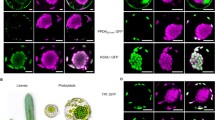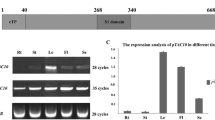Abstract
Nucleus-encoded chloroplast proteins of vascular plants are synthesized as precursors and targeted to the chloroplast by stroma-targeting domains in N-terminal transit peptides. Transit peptides in Chlamydomonas reinhardtii are considerably shorter than those in vascular plants, and their stroma-targeting domains have similarities to both mitochondrial and chloroplast targeting sequences. To examine Chlamydomonas transit peptide function in vivo, deletions were introduced into the transit peptide coding region of the petE gene, which encodes the thylakoid lumen protein plastocyanin (PC). The mutant petE genes were introduced into a plastocyanin-deficient Chlamydomonas strain, and transformants that accumulated petE mRNA were analyzed for PC accumulation. The most profound defects were observed with deletions at the N-terminus and those that extended into the hydrophobic region in the C-terminal half of the transit peptide. PC precursors were detected among pulse-labeled proteins in transformants with N-terminal deletions, suggesting that these precursors cannot be imported and are degraded in the cytosol. Intermediate PC species were observed in a transformant deleted for part of the hydrophobic region, suggesting that this protein is defective in lumen translocation and/or processing. Thus, despite its shorter length, the bipartite nature of the Chlamydomonas PC transit peptide appears similar to that of lumen-targeted proteins in vascular plants. Analysis of the synthesis, stability, and accumulation of PC species in transformants bearing deletions in the stroma-targeting domain suggests that specific regions probably have distinct roles in vivo. Abbreviations: cyt, cytochrome; ECL, enhanced chemiluminescence; LSU, large subunit; PC, plastocyanin; TP, transit peptide
Similar content being viewed by others
References
Archer EK, Keegstra K: Analysis of chloroplast transit peptide function using mutations in the carboxyl-terminal region. Plant Mol Biol 23: 1105–1115 (1993).
Bassham DC, Creighton AM, Karnauchov I, Herrmann RG, Klösgen RB, Robinson C: Mutations at the stromal processing peptidase cleavage site of a thylakoid lumen protein precursor affect the rate of processing, but not the fidelity. J Biol Chem 269: 16062–16066 (1994).
Belknap WR: Partial purification of intact chloroplasts from Chlamydomonas reinhardtii. Plant Physiol 72: 1130–1132 (1983).
Blankenship JE, Kindle KL: Expression of chimeric genes by the light-regulated cabII-1 promoter in Chlamydomonas reinhardtii. A cabII-1/nit1 gene functions as a dominant selectable marker in nit1–nit2– strain. Mol Cell Biol 12: 5268–5279 (1992).
Boutry M, Nagy F, Poulsen C, Aoyagi K, Chua N-H: Targeting of bacterial chloramphenicol acetyl transferase to mitochondria in transgenic plants. Nature 328: 340–342 (1987).
Cerutti H, Johnson AM, Gillham NW, Boynton JE: Nuclear integration and expression of a eubacterial gene conferring spectinomycin resistance on Chlamydomonas reinhardtii. Genetics 145: 97–110 (1997).
Church G, Gilbert W: Genomic sequencing. Proc Natl Acad Sci USA 81: 1991–1995 (1984).
Cline K, Henry R: Import and routing of nucleus-encoded proteins. Annu Rev Cell Devel Biol 12: 1–26 (1996).
Debuchy R, Purton S, Rochaix J-D: The argininosuccinate lyase gene of Chlamydomonas reinhardtii: an important tool for nuclear transformation and for correlating the genetic and molecular maps of the ARG7 locus. EMBO J 8: 2803–2809 (1989).
Durrant I: Light-based detection of biomolecules. Nature 346: 297–298 (1990).
Endo T, Kawamura K, Naka M: The chloroplast-targeting domain of plastocyanin transit peptide can form a helical structure but does not have a high affinity for lipid bilayers. Eur J Biochem 207: 671–675 (1992).
Feinberg AP, Vogelstein B: A technique for radiolabeling DNA restriction endonuclease fragments to high specific activity. Anal Biochem 132: 6–13 (1983).
Franzén L-G, Rochaix J-D, von Heijne G: Chloroplast transit peptides from the green alga Chlamydomonas reinhardtii share features with both mitochondrial and higher plant chloroplast presequences. FEBS Lett 260: 165–168 (1990).
Gray JC, Row PE: Protein translocation across chloroplast envelope membranes. Trends Cell Biol 5: 243–247 (1995).
Harris EH: The Chlamydomonas Sourcebook: A Comprehensive Guide to Biology and Laboratory Use. Academic Press, San Diego, CA (1989).
Howe G, Merchant S: Maturation of thylakoid lumen proteins proceeds post-translationally through an intermediate in vivo. Proc Natl Acad Sci USA 90: 1862–1866 (1993).
Hurt EC, Soltanifar N, Goldschmidt-Clermont M, Rochaix J-D: The cleaveable presequence of an imported chloroplast protein directs attached polypeptides into yeast mitochondria. EMBO J 5: 1343–1350 (1986).
Kindle KL: High-frequency nuclear transformation of Chlamydomonas reinhardtii. Proc Natl Acad Sci USA 87: 1228–1232 (1990).
Kindle KL: Nuclear transformation: technology and applications. In: Rochaix J-D, Goldschmidt-Clermont M, Merchant S (eds) Molecular Biology of Chlamydomonas: Chloroplasts and Mitochondria. Kluwer Academic Publishers, Dordrecht, Netherlands (in press).
Kindle KL, Lawrence SD: Transit peptide mutations that impair in vivo and in vitro chloroplast protein import do not affect accumulation of the gamma subunit of chloroplast ATPase. Plant Physiol 116: 1179–1190 (1998).
Kouranov A, Schnell DJ: Protein translocation at the envelope and thylakoid membranes of chloroplasts. J Biol Chem 271: 31009–31012 (1996).
Kunkel TA, Bebenek K, McClary J: Efficient site-directed mutagenesis using uracil-containing DNA. Meth Enzymol 204: 125–139 (1991).
Kuntz M, Simons J, Schell J, Schreier PH: Targeting of proteins to chloroplasts in transgenic tobacco by fusion to mutated transit peptide. Mol Gen Genet 205: 454–460 (1986).
Lawrence SD, Kindle KL: Alterations in the Chlamydomonas plastocyanin transit peptide have distinct effects on in vitro import and in vivo protein accumulation. J Biol Chem 272: 20357–20363 (1997).
Li HH, Quinn J, Culler D, Dreyfuss BW, Girard-Bascou J, Merchant S: Molecular genetic analysis of plastocyanin biosynthesis in Chlamydomonas reinhardtii. J Biol Chem 271: 31283–31289 (1996).
Ma Y, Kouranov A, LaSala SE, Schnell DJ: Two components of the chloroplast protein import apparatus, IAP86 and IAP75, interact with the transit sequence during the recognition and translocation of precursor proteins at the outer envelope. J Cell Biol 134: 315–327 (1996).
Maniatis T, Fritsch EM, Sambrook J: Molecular Cloning: A Laboratory Manual. Cold Spring Harbor Press, Cold Spring Harbor, NY (1982).
Merchant S, Bogorad L: Regulation by copper of the expression of plastocyanin and cytochrome c552 in Chlamydomonas reinhardtii. Mol Cell Biol 6: 462–469 (1986).
Merchant S, Hill K, Kim JH, Thompson J, Zaitlin D, Bogorad L: Isolation and characterization of a complementary DNA clone for algal pre-apoplastocyanin. J Biol Chem 265: 12372–12379 (1990).
Perry SE, Buvinger WE, Bennett J, Keegstra K: Synthetic analogues of a transit peptide inhibit binding or translocation of chloroplastic precursor proteins. J Biol Chem 266: 11882–11889 (1991).
Perry SE, Keegstra K: Envelope membrane proteins that interact with chloroplastic precursor proteins. Plant Cell 6: 93–105 (1994).
Pilon M, Rietveld AG, Weisbeek PJ, DeKruijff B: Secondary structure and folding of a functional chloroplast precursor protein. J Biol Chem 267: 19907–dy19913 (1992).
Pilon M, Wienk H, Sips W, de Swaaf M, Talboom I, van't Hof R, de Korte-Kool G, Demel R, Weisbeek P, de Kruijff B: Functional domains of the ferredoxin transit sequence involved in chloroplast import. J Biol Chem 270: 3882–3893 (1995).
Quinn J, Li HH, Singer J, Morimoto B, Mets L, Kindle K, Merchant S: The plastocyanin-deficient phenotype of Chlamydomonas ac-208 results from a frame-shift mutation in the nuclear gene encoding preapoplastocyanin. J Biol Chem 268: 7832–7841 (1993).
Quinn JM, Merchant S: Two copper-responsive elements associated with the Chlamydomonas Cyc6 gene function as targets for transcriptional activators. Plant Cell 7: 623–638 (1995).
Reiss B, Wasmann CC, Schell J, Bohnert HJ: Effect of mutations on the binding and translocation functions of a chloroplast transit peptide. Proc Natl Acad Sci USA 86: 886–890 (1989).
Robinson C, Klösgen RB: Targeting of proteins into and across the thylakoid membrane-A multitude of mechanisms. Plant Mol Biol 26: 15–24 (1994).
Schnell DJ, Blobel G, Pain D: Signal peptide analogs derived from two chloroplast precursors interact with the signal recognition system of the chloroplast envelope. J Biol Chem 266: 3335–3342 (1991).
Silva-Filho MD, Chaumont F, Leterme S, Boutry M: Mitochondrial and chloroplast targeting sequences in tandem modify protein import specificity into plant organelles. Plant Mol Biol 30: 769–780 (1996).
Smeekens S, Bauerle C, Hageman J, Keegstra K, Weisbeek P: The role of the transit peptide in the routing of precursors toward different chloroplast compartments. Cell 46: 365–376 (1986).
Stern DB, Radwanski ER, Kindle KL: A 3′ stem/loop structure of the Chlamydomonas chloroplast atpB gene regulates mRNA accumulation in vivo. Plant Cell 3: 285–297 (1991).
Theg SM, Scott SV: Protein import into chloroplasts. Trends Cell Biol 3: 186–190 (1993).
Valentin E, Walker ME, Reid GA: A mutant precursor protein is poorly targeted to mitochondria and interferes in vivo with the import of other mitochondrial polypeptides in Saccharomyces cerevisiae. Curr Microbiol 23: 75–80 (1991).
von Heijne G, Steppuhn J, Herrmann RG: Domain structure of mitochondrial and chloroplast targeting peptides. Eur J Biochem 180: 535–545 (1989).
Waegemann K, Soll J: Phosphorylation of the transit sequence of chloroplast precursor proteins. J Biol Chem 271: 6545–6554 (1996).
Wasmann CC, Reiss B, Bartlett SG, Bohnert HJ: The importance of the transit peptide and the transported protein for protein import into chloroplasts. Mol Gen Genet 205: 446–453 (1986).
Wu C, Seibert FS, Ko K: Identification of chloroplast envelope proteins in close physical proximity to a partially translocated chimeric precursor protein. J Biol Chem 269: 32264–32271 (1994).
Author information
Authors and Affiliations
Rights and permissions
About this article
Cite this article
Kindle, K.L. Amino-terminal and hydrophobic regions of the Chlamydomonas reinhardtii plastocyanin transit peptide are required for efficient protein accumulation in vivo. Plant Mol Biol 38, 365–377 (1998). https://doi.org/10.1023/A:1006025606330
Issue Date:
DOI: https://doi.org/10.1023/A:1006025606330




